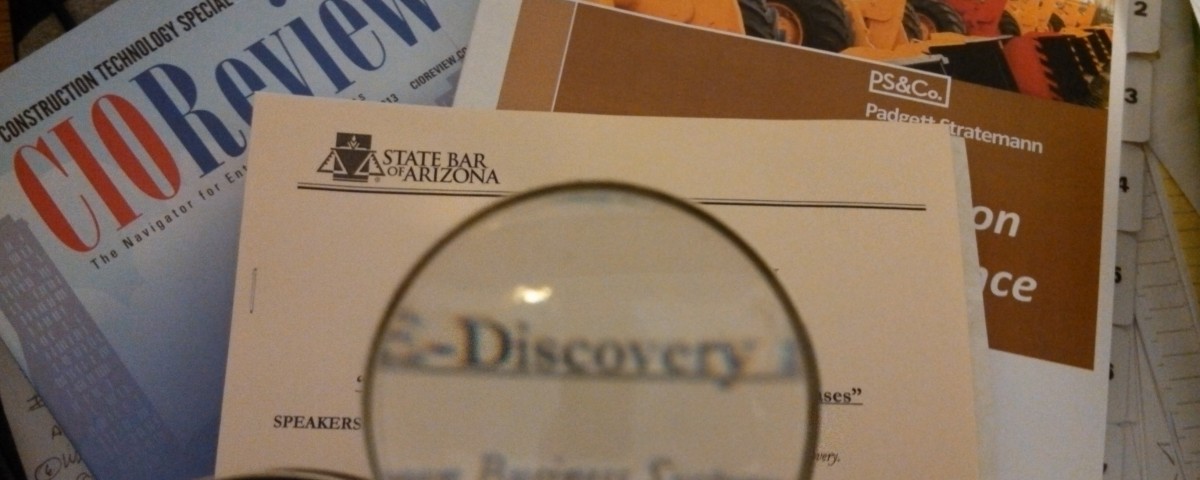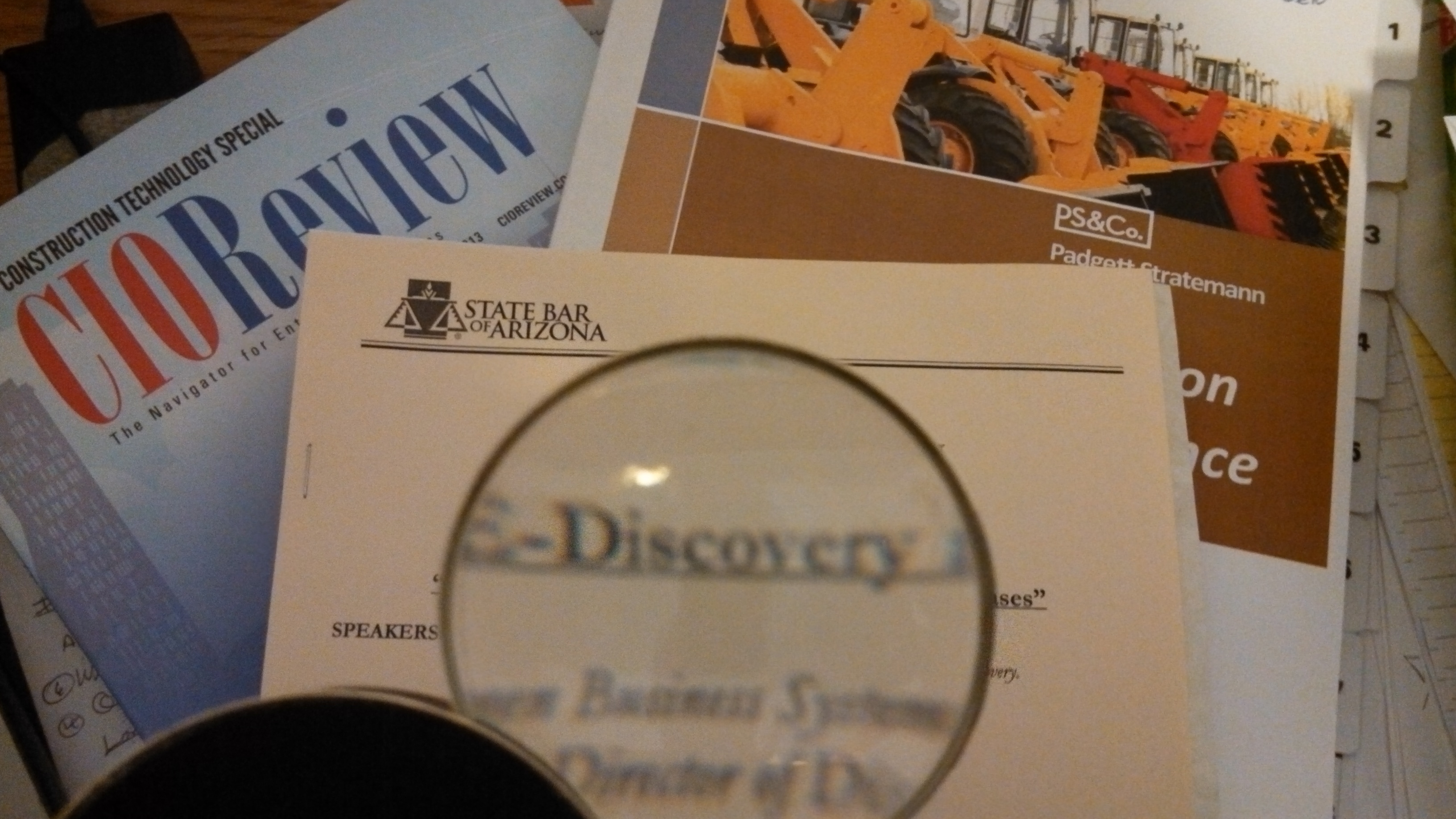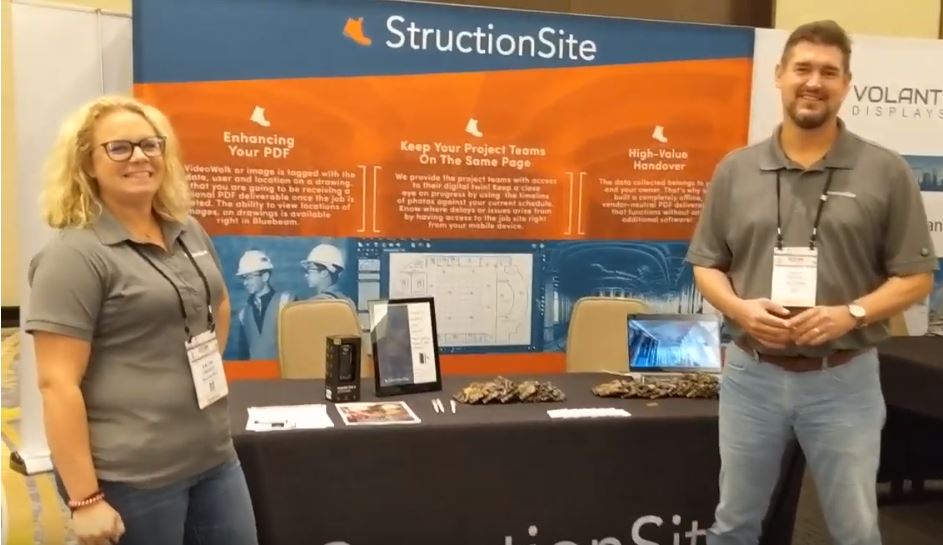- Professional Construction Software Solutions
- 480-705-4241

Quick Bluebeam Tip: Pan and Markup
January 7, 2014
How to Combine Photos into One PDF using Bluebeam
January 9, 2014As a panelist for the Arizona Bar Association luncheon yesterday along with Kathy Kozen, Esq, Director of Discovery Services for D4 E-Discovery and Russell Yurk, Esq, Jennings Haug and Cunningham, a crowd of 80+ lawyers filled the room at the Phoenix Country Club. They asked me to give them an overview of what Enterprise Content Management (ECM) was and what technology construction firms were using to manage their documents. There were cases sited involving email, metadata, and search terms that they asked us to comment on as well.
Here are a few highlights of what I shared that could prove helpful to contractors (and lawyers) to improve their construction document management and avoid unnecessary e-discovery litigation expenses in their future.
In an e-discovery process many documents are extracted for review and the delivered results are something like an ECM system – searchable, sortable, accessible and deliverable.
If you have an ECM system in place prior to litigation you’ll save money in the gathering phase and can produce native documents and metadata if necessary.
Document Management in accounting and project management systems is often a paperclip function and not all are alike. Some merely point to a file address and the link can be lost if the document is moved on a hard drive or archived.
Email is a terrible way to document a construction project and can be costly to recreate the timelines when older email is involved.
Avoiding the use of email, leading firms are collaborating on documents (marking up, editing and producing auditable records) in project management, cloud based systems and PDF editing solutions then importing the documentation into their ECM systems as part of the workflow. Email in these firms may only be a notification system to alert subcontractors and other project stakeholders of request for input or approval on RFIs, submittals, change orders,etc within the Project management or ECM system.
Photo management is exploding and innovative firms are capturing photos throughout the project from mobilization thru the punch process. On large complex projects like hospitals, many are outsourcing the capture of in progress jobsite photo collection at set milestones.
I sited an ENR article from February of 2012 that stated some firms were writing into their contracts that email would not be used for e-discovery on the project – This received many chuckles from the audience, however, as the trend toward less email use continues, there won’t be much value in email – just a bunch of expense. Some judges will uphold this argument as well if both parties had agreed before the project began.
Having a documented records retention and destruction policy can help avert opposing council’s request for you to pull email from backup tapes. Backups are for catastrophic loss (fire, flood, computer hard drive failue, etc). By having an email records retention policy that is followed (you destroy the emails in a timely fashion per the policy) may save you tens of thousands of dollars in e-discovery costs.
Printing out emails and storing them in a physical job folder while deleting the original email (and it’s metadata) could be a records retention policy breach and null your protection. Smart lawyers will ask you to produce the email with metadata since a printed out email could be produced on a typewriter.
ECM can include Word, Excel, Powerpoint, recorded VOIP messages, audio, photos, video, web content, scanned documents, e-forms, Text messages, email and the attachments in any format including .PDF, .DWG, .DWF, .IFC, etc.
It will be difficult to convert Building Information Modeling (BIM) to .TIF as it is a visual 3D rendering. BIM files are exceedingly large. Laser scanning is also becoming commonplace along with augmented reality which will also be “discoverable” in complex cases.
Much of the e-discovery expense is in exporting documents and converting them to a standard readable and searchable formats like .PDF or .TIF.
Bates numbering can be done with .PDF – Bluebeam Revu offers this feature and also has document conversion capabilities for many standard formats.
There will continue to be an explosion of data volume with smartphones, tablets and mobile device use in construction, therefore e-discovery data collection may also grow exponentially.
Without a plan to eliminate silos and share documents across platforms (Sharepoint servers, ECM systems, accounting, project management, mobile devices and other collaborative systems) a construction company increases its exposure as they collect and retain more data.
If you are looking for ECM solutions to make your plan room and/or your entire company electronic, mobile, collaborative, accessible, and auditable, we consult and market ECM and electronic document management systems to the construction industry. Just Email Me what you’re looking to solve and let’s get you started.






